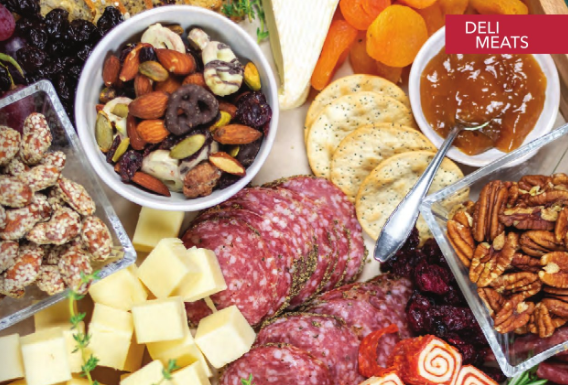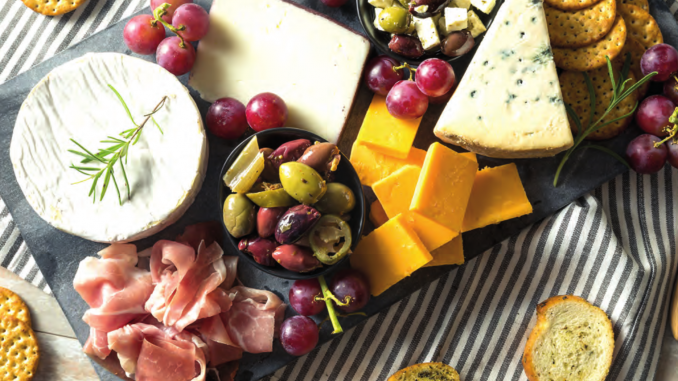Charcuterie: What’s Old is New Again
October 1, 2020 | 9 min to read
Charcuterie boards, once a culinary art rooted in French tradition, are enjoying a modern resurgence, according to Deanna Depke of Volpi Foods. The term, originating from the French words for "flesh" and "cooked," has evolved from a necessity for preserving meat into a luxury trend. With specialty deli meats generating significant sales growth—$200 million in the U.S. alone—this revival reflects a society drawn to both history and innovation in food culture, marking a renewed fascination with charcuterie.

All of a sudden, charcuterie boards are all the rage. They’re taking over restaurant menus and Instagram feeds… and increasingly, supermarket delis. But charcuterie, the French term for the culinary art of preparing meat products such as salami, ham, terrines, galantines, pâtés, confit and dry-cured sausages, is anything but new.
“Charcuterie is the fastest-growing deli meat category,” says Deanna Depke, marketing manager at St. Louis-based Volpi Foods, which has hand crafted Italian cured meats in the American Midwest since 1902.
Pronounced shaar-koo-tr-ee, the word comes from the French chair “flesh” and cuit “cooked.” Considered an important culinary craft since at least the 15th century, the specialized shop selling confits, foie gras and a selection of prepared foods is also called a charcuterie. Their owners, charcutiers, would hang their goods in their shop windows to draw customers in. But the French don’t have a monopoly on a tradition of cured meats—the German delicatessen and the Italian salumeria are also meat meccas, as are Spanish markets with their stunning legs of jamón.
What today is a luxury began as a necessity. Way before refrigerators, humans needed to preserve meat so that they could enjoy it before it spoiled. It’s reasonable conjecture that early woman might have hung a fresh catch near the fire and realized that the smoke transformed the meat into something that lasted significantly longer and was unusually delicious.
Sausage recipes date to before the golden age of ancient Greece, and cured meats have been made for over 2000 years in Italy, France and beyond. Like pickles, craft beer and kombucha, charcuterie has been revived and brought front and center by a food world enamored with both tradition and innovation.
According to Chicago-based Nielsen Perishables Group, dollar and volume growth from the specialty deli meat segment accounts for $200 million of the $9 billion meat and deli counter business in the U.S. Chicago-based IRI reported sales of “charcuterie types of packaged lunch meats” reached $561 million in 2019, up 8.1% from the previous year, and sales of “charcuterie types of packaged meat snacks/meals” were up 6.5% to a total of $378 million. Charcuterie is resonating like never before.

Why So Popular?
Just like a cheese board, a charcuterie platter is an ideal way to please all palates and delight hungry crowds, big and small. (Plus, the result can be quite pretty and social media worthy!)
Charcuterie, with its rich history, satisfies consumers’ hunger for authenticity. It is seen as wholesome, “real” food with an authentic story. In the time of a global pandemic, it’s a protein-packed meal or snack perfect for the whole family that feels like a special treat when times are tough. It can be dressed up into a gorgeous platter or served with a simple salad for a quick, yummy meal.
The added convenience of pre-sliced meat, and meat and cheese snack sticks, is another boon. Growth is happening with grab-and-go package options like pre-sliced salami, salamini sticks, snacking items and entertaining trays.
“The category has historically been driven by older generations,” says Al Adelson, vice president of sales at Veroni USA, based in Swedesboro, NJ. “However, salame now appeals to the younger demographics and foodies looking for more flavorful, higher protein and convenient meal options.” What was once the domain of fancy restaurants and specialty shops is now proliferating in supermarket delis for a much broader audience. More domestic producers are trying their hands at artisanal charcuterie, and more selection is available from Europe.
Another factor helping increase sales and interest is the greater availability of specialty heritage cuts from small producers, especially those that are hormone- and antibiotic-free, and humanely raised. From Olli Salumeria, an artisanal slow-cured fine meats supplier in Oceanside, CA, to Volvi, to Creminelli in St. Louis to Charlito’s Cocina in Queens, NY, American producers are stepping up in a serious way. They often feature charcuterie products made from heritage breeds—ones that were once raised by our ancestors
“The value proposition and understanding of the category has also changed,” explains Adelson. “Consumers are willing to pay a premium when it comes to their eating experience with indulgent food, even more so now as people are looking for a restaurant-quality experience in the comfort of their own home.”
As travel has been put on hold because of the pandemic, charcuterie boards offer people the chance to “travel” through new flavor experiences. “COVID-19 has fast-tracked changing consumer demands,” says Depke. “We are responding with several new items that appeal to smaller households and can fit into a variety of consumption occasions. Our Small Bites line will be comprised of single-serving pre-sliced charcuterie selections and will launch just in time for socially-distanced holidays.”
Hayward, CA-based Columbus Meats is a maker of everything needed in a charcuterie landscape. “We’ve focused on bringing education to shoppers with charcuterie so they can adopt this into their everyday lives,” says Evan Inada, the company’s charcuterie/partnerships director.
The company’s super premium meats feature artisan craftsmanship. Its product has been dry cured from start to finish since the company was founded back in 1917.
Its latest product is a charcuterie tasting board, which includes a faux wood plastic tray with two salamis, La Panzanella artisan crackers, dark chocolate and dried cranberries.
“These are traditional items from a charcuterie board,” says Inada. “By putting flavors together, we’re educating shoppers on how to buy and make charcuterie.”

Products to Discover
PROSCIUTTO, JAMÓN SERRANO, JAMÓN IBÉRICO
“Prosciutto” is Italian for ham, and is usually used to describe the seasoned, cured, air-dried ham that comes in whisper-thin slices. The original prosciutto hails from Italy, but quality versions are now made elsewhere, including high-quality American versions. Jamón ibérico, as the name suggests, is made only from the Iberian pig and cured for 14 to 36 months. Serrano ham may be made from several different breeds of white pigs, such as Duroc, Landrace or Large White. The French jambon de Bayonne, a delicate and yet also complex cured ham, is made in a similar style.
PÂTÉS AND TERRINES
“Pâtés and terrines, broadly speaking, are essentially big sausages cooked in some sort of mold,” Michael Ruhlman wrote in his book “Charcuterie: The Craft of Salting, Smoking, and Curing”. Think Terrine des Trois Rois (“three kings”), with layers of chicken, decadent foie gras and Armagnac-marinated prunes, a great example of a traditional meat terrine. Creamy chicken liver pâté is also a favorite, as is Pâté de campagne, a coarse grind of pork with spices. Mushroom and white bean pâté is one of several vegetarian options.
BOUDIN
Usually available in blanc and noir (white and black), these savory sausages are made from ground, spiced meat packed in natural casings and then poached or blanched. Deep red boudin noir is named for the addition of pig’s blood to the sausage.
SAUCISSON
Dry-curing is simply preserving meat by using salt, and saucisson is dry-cured, fermented salami. Saucisson sec is a thick and rich salami, similar to pepperoni.
RILLETTES
Slowly cooking rabbit, pork or duck in fat until meltingly tender yields rillettes, pronounced ree-yet. The meat is then shredded and sesasoned to make a savory spread known in the Tours region of France as brown jam.
MORTADELLA
An emulsified sausage with origins in Bologna, Italy, Mortadella is sort of like boloney for grownups. It’s crafted with cured pork with least 15% pork fat cubes, whole or chopped pistachios, and spiced with black pepper and myrtle berries.
LONZA
Lonza is made by dry-curing and smoking boneless pork loins with spices (the same cut of meat that gives us pork chops). Leaner than most charcuterie, this may also be referred to as Lomo (in Spanish) or Lombo.
SOPPRESSATA
Soppressata is a dry salami that comes from the Calabria, Vicenza and Tuscany regions of Italy. There are many variations and flavors, including cumin, black pepper, red pepper and chili peppers.
BRESAOLA
This deep red, aromatic delicacy is made from beef tenderloin that’s been air-dried and salted. Less commonly, it may be made with bison or venison. A good choice for those looking for a non-pork product.
LARDO
Lardo is made by curing strips of fatback with rosemary and other herbs and spices. It’s silky sweet and full of gentle, rich flavor. Traditionally, lardo was cured in boxes made from Carrara marble, the valuable local stone from in Colonnata, Italy.
‘NDUJA
Pronounced en-doo-ya, ‘nduja is a spicy, spreadable pork—usually made with parts of the pig such as the shoulder and belly as well as tripe, roasted peppers and a mixture of spices. Similar to sobrassada from the island of Mallorca in Spain, it’s originally from Spilinga, in Calabria. Spread it on crackers or add it to pizza or pasta.
MOUSSE
A mousse is like a pâté, but much more finely ground, with a smoother texture. There’s usually a healthy amount of liver for a decadent and creamy finish. Chicken liver mousse is quintessential. Mousse Truffée is a spreadable turkey and chicken liver mousse studded with black truffles.
CHORIZO
Chorizo (of Spanish origin) or chouriço (the Portuguese version) is a type of pork sausage, seasoned with paprika and garlic. Fermented, cured and smoked, chorizo is a great addition to eggs and shellfish dishes, or sliced on a charcuterie platter.
Merchandising and Marketing
Grocers are spotlighting the category with enhanced and multiple displays featuring a variety of grab-and-go sliced meats as well as snacks and kits. Adelson says “Veroni is seeing tremendous growth in antipasto packs combining salami and cheese or multiple salame varieties. Consumers like variety and pairings already created for them.”
Inada at Columbus Meats says retailers are honing in on the charcuterie trend by breaking it down to include specialty items in one place. “Now more than ever people are looking for quick, easy solutions, not just for small social gatherings, but also for quality of life purchases.”
Charcuterie lends itself beautifully to cross merchandising, as it’s simple and fun to pair. Cured meats are complemented by something acidic, like cornichons, those tiny and cute French pickles. Whole-grain mustard makes a nice accompaniment, as do olives and cheeses. Honey and jam can lend a welcome sweet contrast to all that savory meatiness.
A serving rule of thumb is about 2 ounces per person. Add rustic country bread or your favorite crackers. Juicy, medium-bodied red wines like Côtes-du-Rhône, Gigondas or Madiran make for a perfect pairing.
Engagement and education can welcome customers into a category that can feel intimidating. Demoing is challenging during the time of COVID, but recipe cards, online classes and pairing ideas can help engage and inspire customers.In addition to offering prepackaged, grab-and-go charcuterie options, some grocers have embraced charcuterie along with artisanal cheeses as a catering option or as stand-alone sections in their stores, especially at higher-end locations. “Retailers can capitalize on this trend in many departments of the deli,” says Adelson. “It’s a great opportunity.” DB
2 of 9 article in DeliBusiness Oct/Nov 2020

